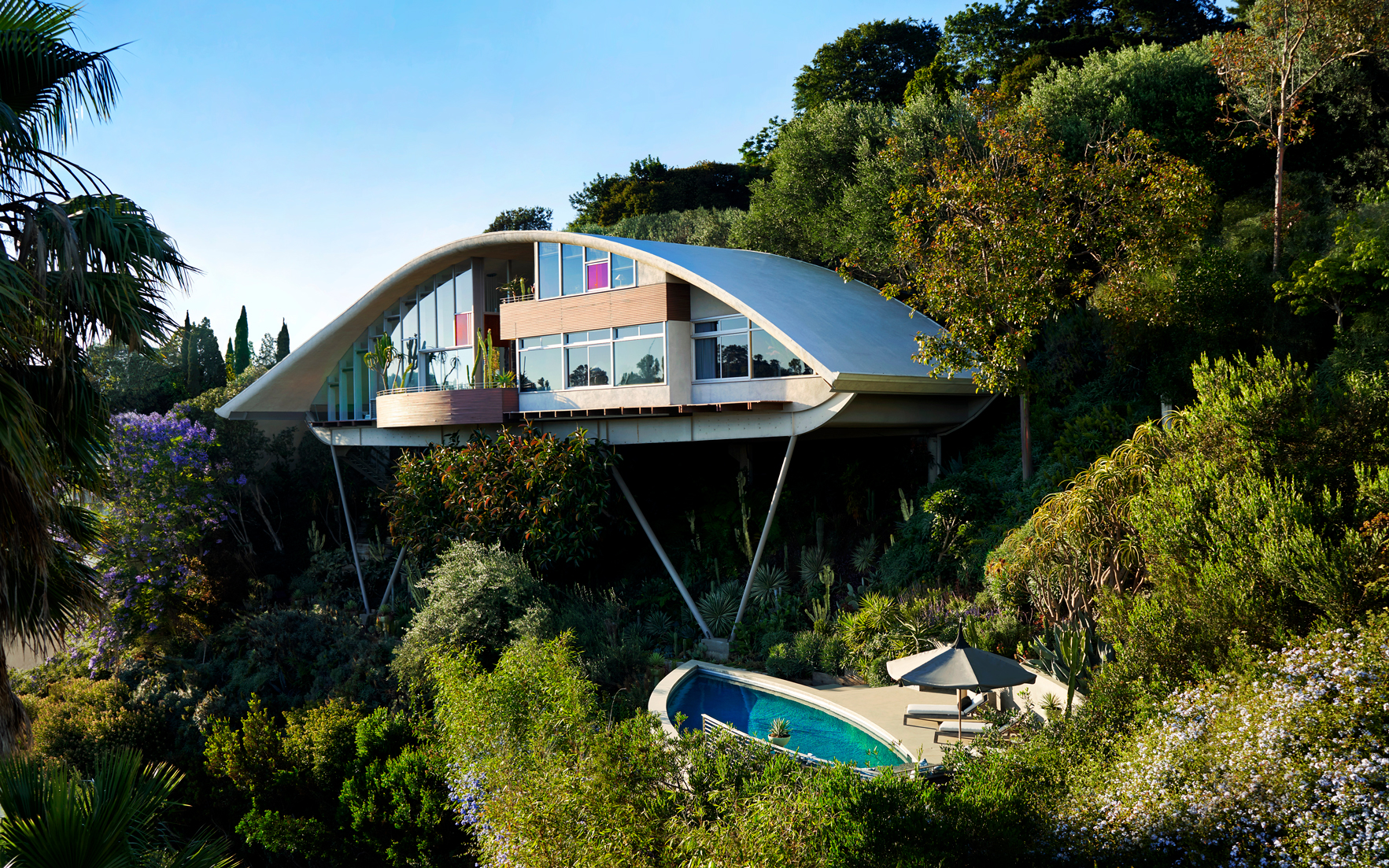‘California living at its best’: John Lautner’s Garcia House
An inside look at a Hollywood Hills icon designed by one of the 20th century’s most famous architects

All photos: Roger Davies
Suspended 60 feet over California’s Mulholland Drive, the silver half-moon roof of John Lautner’s 1960s Garcia House eclipses over the treetops. The space offers a living experience unlike any other.
Lautner, a protégé of famed architect Frank Lloyd Wright, designed the home for musical composer Russell Garcia and his wife, creating a residence that would become a piece of West Coast history. Over the ensuing decades, the home has served as a backdrop for star-studded photoshoots, welcoming film stars like Scarlett Johansson and the rapper Saweetie, graced the cover of magazines and played a cameo role in the 1989 film Lethal Weapon 2 alongside Mel Gibson.
With its plate glass windows, tear-shaped pool and hand-poured terrazzo floors, the home is a living artwork imbued with Hollywood history. Now, for the first time in 20 years, the three-bedroom, three-bathroom architectural icon is available through Christie’s International Real Estate.
Custodians of a masterpiece
When current owners, John McIlwee and Bill Damaschke, bought the Garcia House in 2002, it was in need of a facelift. Over the subsequent years, the couple undertook a painstaking renovation of both the interior and exterior spaces.
The living room of the Garcia House overlooking Mulholland Drive
Like a collector buying a painting, McIlwee and Damaschke consider themselves the temporary custodians of a masterpiece, responsible for its upkeep and maintenance until its time to pass to the next steward. ‘I love contemporary houses and I also love historical ones like the Garcia House,’ says McIlwee, who also serves on the board of The John Lautner Foundation. ‘Each has their own unique place in history, and each should be honoured for what they are.’
As part of this commitment, the couple set about restoring the distinctive details of the Garcia House to their former glory, including a reversion to the original floor plan, a redesign of the gardens and the installation of a pool that was part of Lautner’s overall design scheme but never fully realized. Celebrated architecture firm Marmol Radziner was tapped for the restoration, while interior designer Darren Brown overhauled the décor and John Sharp updated the landscaping.
The owners' record and vinyl collection on display in the living room of the Garcia House
The result is a glamorous dwelling with hints of Studio 54 — both sophisticated and comfortable. The renovations were so well done, in fact, that many visitors assumed the couple bought the house as-is, in a perfect mid-century modern state.
A unique piece of art
With its space-age feel, the Garcia House demands a certain kind of interior. McIlwee and Damaschke have responded by cultivating a carefully curated art collection with the help of advisor Simon Oldfield, peppered amongst both retro and contemporary objects. ‘The house itself is its own unique piece of art. We’ve been able to integrate and collaborate with it, but in a way that doesn’t conflict with the architecture,’ explains McIlwee.
An Annie Lapin painting hangs from the ceiling in the living room and a wall of Cindy Sherman and Alex Prager portraits bedecks the master bedroom. The couple adores the neon paintings of Ed Paschke, and the artist’s 1980 work Labula commands the spotlight in the media room.
Ed Paschke's Labula hangs in the media room of the Garcia House. Ed Paschke, Labula, 1980 © Ed Paschke
They are not just focused on coordinating items with the architecture, however, but also art with design elements. A painting by Kirsten Everberg sits above a Lucite four-poster bed by Charles Hollis Jones. A Venini lamp mingles with a Diane Arbus photograph. Works by contemporary stars such as Terry Richardson, Torbjørn Rødland and Raymond Pettibon are sprinkled throughout the interior.
These standout aesthetic pairings, the couple feel, are largely owed to the distinct living experience of the house, and the constant inspiration it provides. ‘We’ve collected some important historical pieces, but a lot of our stuff is cutting-edge contemporary,’ says McIlwee. ‘We’ve made some bold choices, and we feel that much of what we’ve bought we’ve been able to acquire because of the house.’
Working with the landscape
The garden has also been a source of inspiration and an opportunity for innovation. One of Lautner’s primary design principles was to work with the surrounding landscape, not against it. He never reworked a property to fit a home. Instead, he designed his structures to fit within the quirks of a property.
Left: the entrance to the Garcia House; Right: the tear-shaped pool, based on John Lautner's original design
Many of his most idiosyncratic designs— like the nearby Chemosphere, a home that looks like an octagonal spaceship atop a concrete flagpole — were constructed on otherwise unbuildable lots.
Keeping true to Lautner’s original vision, the couple set out to revamp the landscape. Blending the Garcia House seamlessly with its surroundings.
After several false starts, McIlwee and Damaschke found the perfect landscape designer in Sharp. ‘What he came up with was nothing short of remarkable,’ says McIlwee. The result is a verdant jungle that incorporates totem poles covered in selenite crystals and nearly 200 species of cacti and ferns, including rarities like the milky white ghost euphorbia.
The outdoor deck that connects both sides of the Garcia House
Across his 20 years at Garcia House, it is this experience of living harmoniously with their surroundings that McIlwee appreciates most. ‘Lautner forces you to go outside,’ he explains. Traversing the house, with its two equidistant sections separated by an exterior spiral staircase, requires frequent trips outside. ‘When we have our coffee in the morning or people come over for a party, you have to go out across the deck, and it forces you to stop and marvel at the landscape. It’s California living at its best, which is what Lautner was known for.’

No comments:
Post a Comment